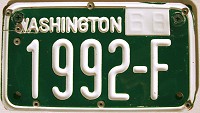
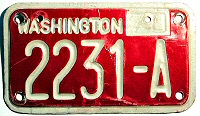
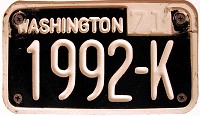
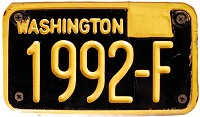
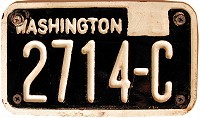
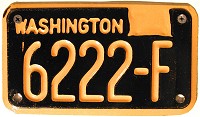
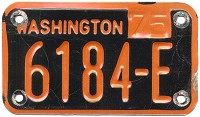
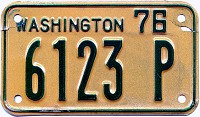
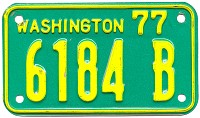
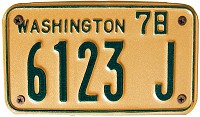
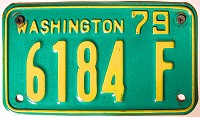
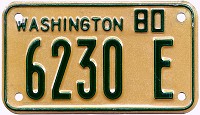
For plates dated 1916 through 1953, plates were enlarged slightly from the standard motorcycle plate format to accommodate the word "DEALER" above the registration number. From 1954-1957, motorcycle dealer license plates were identical to regular motorcycle plates in size and format, but had a stacked "DL" prefix (suffix in 1954) instead of a stacked "MO" prefix (suffix in 1954). For 1958-1964, they were made in the standard motorcycle design, with an "MO" prefix, but had serials starting with the letter D. 1965-1967 plates were similar to this style, but the serial number could start with any letter of the alphabet (regular motorcycle serials were all-numeric). 1968 and later plates are pictured and described in further detail below.
 |
1968 - Motorcycle dealer plates were enlarged to be the same size as the new regular motorcycle plates that debuted the same year, but were not reflectorized until 1969. For 1968 through 1975, the two-digit year is lightly debossed in the "well" to the right of the state name. Plate numbers corresponded to the dealer number, and the letter was used as a serial indicator. So, for example, this plate shows that dealer #1992 had at least six license plates (with suffixes A through F, and perhaps more) in 1968. The plate pictured here was so heavily used that it began to crack, prompting someone at the dealer to rivet it to a heavy steel backing plate. 1969 and 1970 motorcycle dealer plates were of similar design, but were made using white reflective sheeting, debossed, and painted red, giving a fully reflective plate with white letters/numbers and a red background. |
 |
1970 - Continuation of the 1968 design. Same colors and format as 1969. |
 |
1971 - Continuation of the 1968 design. Reflective white sheeting. Notice that the number dies are different than on the 1968 plate (especially the 9 and 2). The die change was made around 1969. |
 |
1972 - Continuation of the 1968 design. Reflective lemon-yellow sheeting. |
 |
1973 - Continuation of the 1968 design. Reflective white sheeting. |
 |
1974 - Generally speaking, this is a continuation of the 1968 design and is a reflective plate. However, 1974 saw the introduction of a new class of dealer, "miscellaneous," which included trailer and motorcycle dealers. Trailer dealers received full-sized black on reflective gold plates, with the legend "WASHINGTON DLR 74" across the top and "MISC" vertically at the left. Serial numbers were restricted to the 6000 series. Motorcycle dealers, as a subset of this classification, received small-sized plates using the same reflective gold background and black paint, likewise with numbers confined to the 6000 series. As before, the number was the dealer number and the letter was a serial indicator. This format continues to the present time. |
 |
1975 - very similar to 1974, but using a darker orange reflective material. |
 |
1976 - The plate design was slightly revised for 1976, as it was for regular motorcycle license plates which began to be embossed rather than debossed. This unusual green on reflective tan color combination was also used in 1978 and 1980. |
 |
1977 - These yellow on reflective green colors were also used in 1979 and on the undated 1981-1987 motorcycle dealer base. |
 |
1978 |
 |
1979 |
 |
1980 - The final year for dated, annual issue non-passenger license plates. |
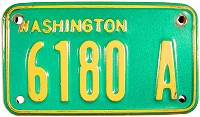 |
1981-87 - This style of plate first appeared in 1981, and was renewed with standard passenger year stickers from 1981 through 1987. Month stickers first came into use for dealer plates in 1986. This particular plate has a note on the back indicating that it was issued to Klein Honda in Everett. |
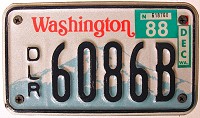 |
1988-99 - This style of plate appeared at the same time as the Mt. Rainier/Centennial base dealer plates, which were first used with a 1988 sticker. All existing motorcycle dealer plates were replaced. The design continued to be issued into 1999, when the motorcycle plate style was very slightly revised (the typeface of the state name was changed, and the blue outer border was removed). |
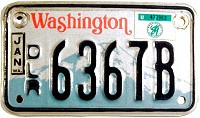 |
1989 |
| All material © 2004 by Ian Slade. Please do not reproduce any content without written consent of the owner. |